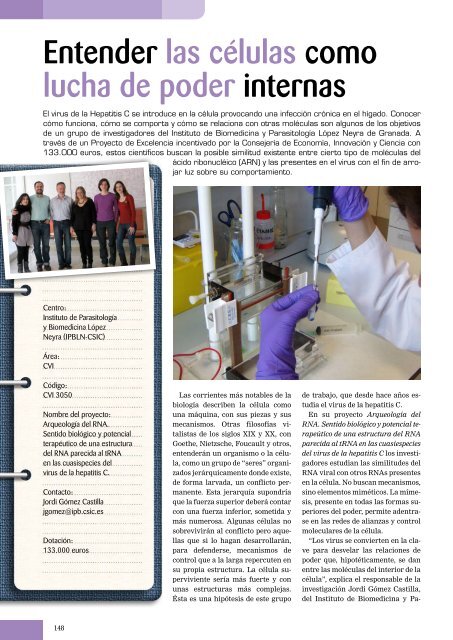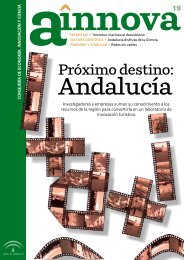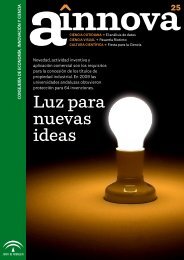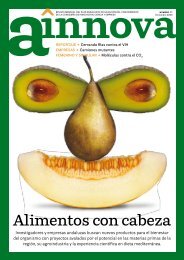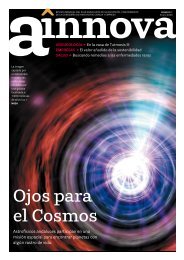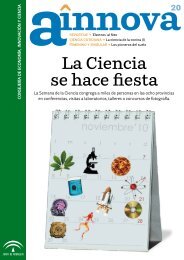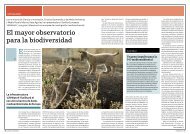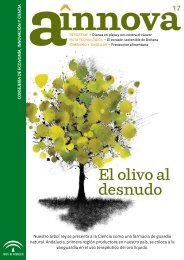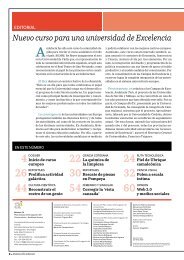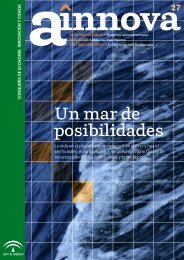ciencias de la vida
ciencias de la vida
ciencias de la vida
Create successful ePaper yourself
Turn your PDF publications into a flip-book with our unique Google optimized e-Paper software.
Enten<strong>de</strong>r <strong>la</strong>s célu<strong>la</strong>s como<br />
lucha <strong>de</strong> po<strong>de</strong>r internas<br />
El virus <strong>de</strong> <strong>la</strong> Hepatitis C se introduce en <strong>la</strong> célu<strong>la</strong> provocando una infección crónica en el hígado. Conocer<br />
cómo funciona, cómo se comporta y cómo se re<strong>la</strong>ciona con otras molécu<strong>la</strong>s son algunos <strong>de</strong> los objetivos<br />
<strong>de</strong> un grupo <strong>de</strong> investigadores <strong>de</strong>l Instituto <strong>de</strong> Biomedicina y Parasitología López Neyra <strong>de</strong> Granada. A<br />
través <strong>de</strong> un Proyecto <strong>de</strong> Excelencia incentivado por <strong>la</strong> Consejería <strong>de</strong> Economía, Innovación y Ciencia con<br />
133.000 euros, estos científicos buscan <strong>la</strong> posible similitud existente entre cierto tipo <strong>de</strong> molécu<strong>la</strong>s <strong>de</strong>l<br />
ácido ribonucléico (ARN) y <strong>la</strong>s presentes en el virus con el fin <strong>de</strong> arrojar<br />
luz sobre su comportamiento.<br />
Centro:<br />
Instituto <strong>de</strong> Parasitología<br />
y Biomedicina López<br />
Neyra (IPBLN-CSIC)<br />
Área:<br />
CVI<br />
Código:<br />
CVI 3050<br />
Nombre <strong>de</strong>l proyecto:<br />
Arqueología <strong>de</strong>l RNA.<br />
Sentido biológico y potencial<br />
terapéutico <strong>de</strong> una estructura<br />
<strong>de</strong>l RNA parecida al tRNA<br />
en <strong>la</strong>s cuasispecies <strong>de</strong>l<br />
virus <strong>de</strong> <strong>la</strong> hepatitis C.<br />
Contacto:<br />
Jordi Gómez Castil<strong>la</strong><br />
jgomez@ipb.csic.es<br />
Dotación:<br />
133.000 euros<br />
Las corrientes más notables <strong>de</strong> <strong>la</strong><br />
biología <strong>de</strong>scriben <strong>la</strong> célu<strong>la</strong> como<br />
una máquina, con sus piezas y sus<br />
mecanismos. Otras filosofías vitalistas<br />
<strong>de</strong> los siglos XIX y XX, con<br />
Goethe, Nietzsche, Foucault y otros,<br />
enten<strong>de</strong>rán un organismo o <strong>la</strong> célu<strong>la</strong>,<br />
como un grupo <strong>de</strong> “seres” organizados<br />
jerárquicamente don<strong>de</strong> existe,<br />
<strong>de</strong> forma <strong>la</strong>rvada, un conflicto permanente.<br />
Esta jerarquía supondría<br />
que <strong>la</strong> fuerza superior <strong>de</strong>berá contar<br />
con una fuerza inferior, sometida y<br />
más numerosa. Algunas célu<strong>la</strong>s no<br />
sobrevivirán al conflicto pero aquel<strong>la</strong>s<br />
que si lo hagan <strong>de</strong>sarrol<strong>la</strong>rán,<br />
para <strong>de</strong>fen<strong>de</strong>rse, mecanismos <strong>de</strong><br />
control que a <strong>la</strong> <strong>la</strong>rga repercuten en<br />
su propia estructura. La célu<strong>la</strong> superviviente<br />
sería más fuerte y con<br />
unas estructuras más complejas.<br />
Ésta es una hipótesis <strong>de</strong> este grupo<br />
<strong>de</strong> trabajo, que <strong>de</strong>s<strong>de</strong> hace años estudia<br />
el virus <strong>de</strong> <strong>la</strong> hepatitis C.<br />
En su proyecto Arqueología <strong>de</strong>l<br />
RNA. Sentido biológico y potencial terapeútico<br />
<strong>de</strong> una estructura <strong>de</strong>l RNA<br />
parecida al tRNA en <strong>la</strong>s cuasiespecies<br />
<strong>de</strong>l virus <strong>de</strong> <strong>la</strong> hepatitis C los investigadores<br />
estudian <strong>la</strong>s similitu<strong>de</strong>s <strong>de</strong>l<br />
RNA viral con otros RNAs presentes<br />
en <strong>la</strong> célu<strong>la</strong>. No buscan mecanismos,<br />
sino elementos miméticos. La mímesis,<br />
presente en todas <strong>la</strong>s formas superiores<br />
<strong>de</strong>l po<strong>de</strong>r, permite a<strong>de</strong>ntrase<br />
en <strong>la</strong>s re<strong>de</strong>s <strong>de</strong> alianzas y control<br />
molecu<strong>la</strong>res <strong>de</strong> <strong>la</strong> célu<strong>la</strong>.<br />
“Los virus se convierten en <strong>la</strong> c<strong>la</strong>ve<br />
para <strong>de</strong>sve<strong>la</strong>r <strong>la</strong>s re<strong>la</strong>ciones <strong>de</strong><br />
po<strong>de</strong>r que, hipotéticamente, se dan<br />
entre <strong>la</strong>s molécu<strong>la</strong>s <strong>de</strong>l interior <strong>de</strong> <strong>la</strong><br />
célu<strong>la</strong>”, explica el responsable <strong>de</strong> <strong>la</strong><br />
investigación Jordi Gómez Castil<strong>la</strong>,<br />
<strong>de</strong>l Instituto <strong>de</strong> Biomedicina y Pa-<br />
148


